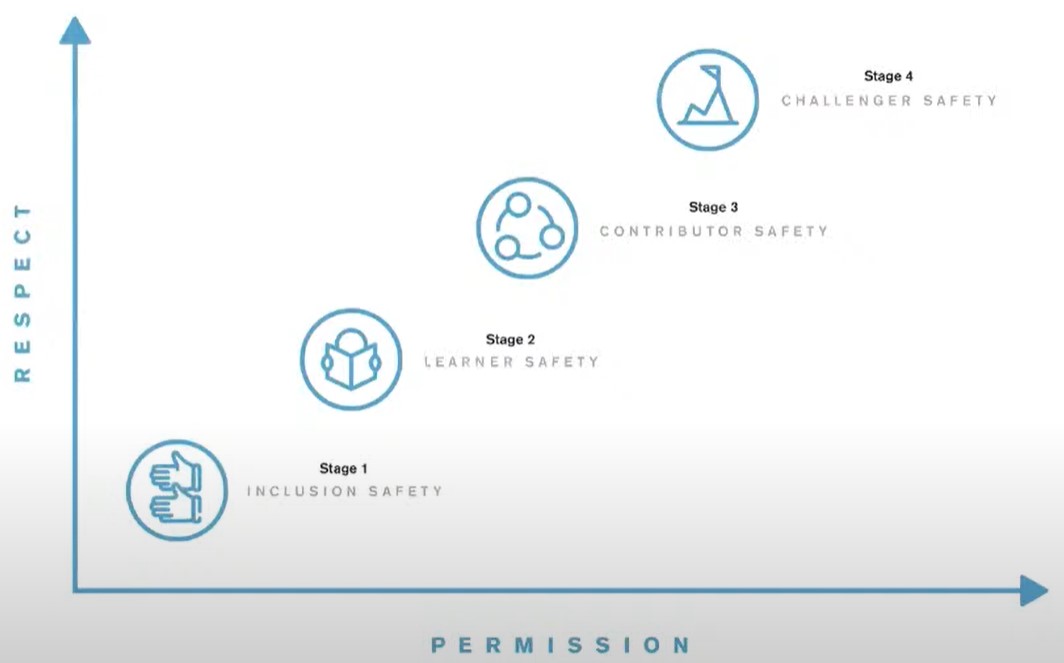In the recent ViewPoint survey on Diversity and Inclusion (D&I), only a quarter of respondents connected psychological safety to D&I. Maybe because the term is not in everyday use or the concept is covered by generic terms scoring higher. Regardless of reason, there is much to be gained for companies with a high degree of physiological safety as it enables employees to successfully challenge and innovate.
So, what is psychological safety? That question is best answered by using the definition used by Amy Edmundson, Professor of Leadership at Harvard Business School. According to her psychological safety “is the belief that one will not be punished or humiliated for speaking up with ideas, questions, concerns, or mistakes.”
Taking this further, Dr.Timothy Clark founder and CEO of LeaderFactor, a global consulting, coaching, and training organization, explains in his book The 4 Stages of Psychological Safety: Defining the Path to Inclusion and Innovation (2020) how psychological safety follows a progression based on the natural sequence of human needs. First, human beings want to be included. Second, they want to learn. Third, they want to contribute. And finally, they want to challenge the status quo when they believe things need to change. This pattern is consistent across all organizations and social units.
Clark explains that to have psychological safety people need to receive varying levels of respect from another person. Then they also need to be allowed varying degrees of permission, i.e. the degree to influence and participate in what they are doing. These are shown on the following diagram with the degree of psychological safety increasing along the axes.

The first step involves encouraging engagement and interaction with open dialogue fostering constructive debate among all team members. The next step allows newer team members to question, experiment and learn from mistakes in a positive rather than negative way. At the next stage, members begin to feel valued and fairly treated and believe that their ideas and opinions matter and make a genuine contribution. At the final stage, members feel confident to challenge and innovate more. This is not so much challenging authority but more highlighting overlooked or contentious aspects.
It is generally accepted that increasing psychological safety leads to a culture that encourages, recognizes and rewards individuals for their contributions and ideas when taking interpersonal risks. If this is absent in an organization, then building successful teams and improving innovation can be compromised. In DNV’s ViewPoint survey, only 26% connected psychological safety when asked what D&I means to them as an individual. Most respondents pointed to broader topics such as equal opportunities (65%) and acceptance (58%).
Commercial organizations survive by maintaining competitive advantage by being innovative in creating new products and services. While individuals can be innovative, the best innovations often come from inviting and welcoming diverse perspectives. This creates high intellectual friction and low social friction. When social friction is high, people do not get along and teams do not work together. Psychological safety brings the feeling of inclusion which acts as an enabler for diversity. A diverse workforce where people also feel included and valued for who they are will feel free to speak their mind. This enables a creative environment which leads to innovation and business benefits.
Understanding this is a key requirement for leaders and today is the fourth hottest topic in leadership training. Leaders who value positional power, authority and dominance may be creating the exact opposite of the culture needed for innovation and competitive advantage as they create fear that freezes up creativity, commitment and represses innovation. Instead, a culture is needed where people are more likely to be benevolent, compassionate, and kind. Leaders need to manage both high intellectual friction and help to create low social friction. This is a key skill for diverse and inclusive leadership and essential for companies to build psychological safety, high-performing teams and derive business benefits.
References:
The 4 Stages of Psychological Safety – Defining the Path of Inclusion and Innovation, Brett-Koehler Publishers, Inc. 2020 / https://www.leaderfactor.com/4-stages-of-psychological-safety
The Fearless Organization – Creating Psychological Safety in the Workplace for Learning, Innovation. And Growth, Amy C. Edmundson, Harvard Business School, Wiley 2019.
